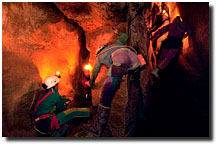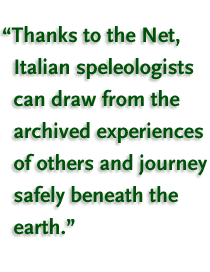
|
|
|
On February 8, 1996, a group of amateur spelunkers descended into the Cave of the Black Reef near Genoa, Italy. When they resurfaced, they posted notes and maps to a website as a reference for future cavers. (Photograph by Enrico Bossan)
|
|
|
|
 lmost every weekend somewhere in Italy, groups of otherwise normal people crawl through mud, squeeze between rocks, and descend sheer cliffs into absolute darkness beneath the earth's surface -- just for fun. In the world of light, these amateur spelunkers are journalists, doctors, engineers, and students. They're also enthusiastic Web surfers who have turned the Net into an important safety device for explorers up and down the porous peninsula.
lmost every weekend somewhere in Italy, groups of otherwise normal people crawl through mud, squeeze between rocks, and descend sheer cliffs into absolute darkness beneath the earth's surface -- just for fun. In the world of light, these amateur spelunkers are journalists, doctors, engineers, and students. They're also enthusiastic Web surfers who have turned the Net into an important safety device for explorers up and down the porous peninsula.
|
|





